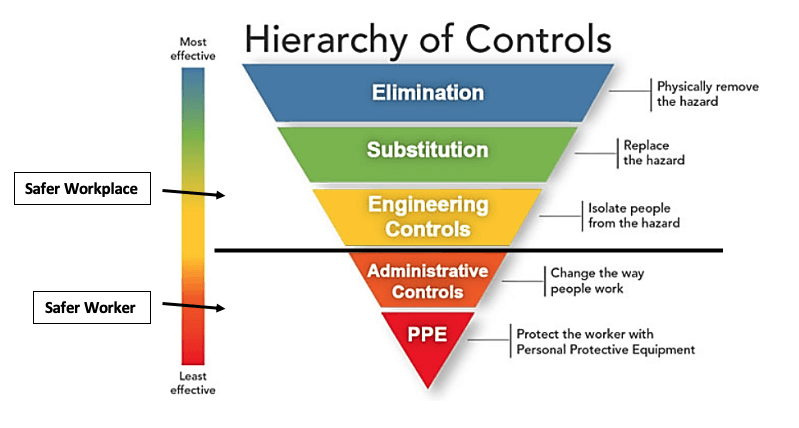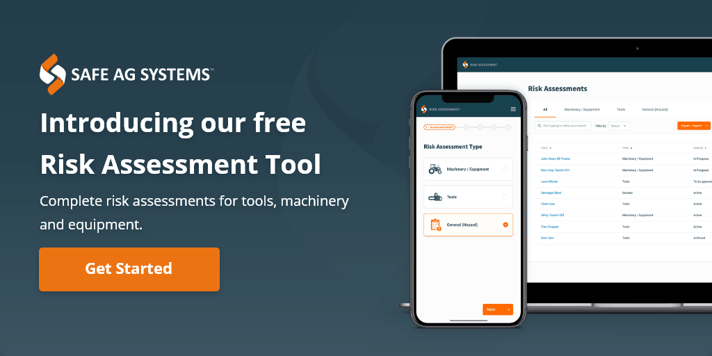Streamline hazard identification and utilise a risk management plan template with our free risk assessment tool.
Risk = the likelihood or chance of a hazard resulting in incident or injury. In other words, the likelihood of something going wrong.
The purpose of a risk management framework is to eliminate or reduce risk. The risk management process to achieve this is very simple – keep S.A.F.E.
S = see it. Identify the hazards and things that could hurt someone.
A = assess it. Think about what harm could come from the hazard, and how serious it might be.
F = fix it. Put ‘risk controls’ in place to eliminate or reduce the risk.
E = evaluate it. Did the risk controls work as you thought? This gives you a chance to tweak things to improve farm safety. Keep tweaking until you’re happy you’ve got things as good as possible.
1. See it.
Identify what can hurt you.
This can be done many ways, from hazard reports logged by your workforce, workplace inspections identifying issues, or as a result of an incident investigation.
Even just walking around, you will spot things that could potentially harm someone or cause damage.
Generally, with hazard identification if you can fix it on the spot, do to and unless it’s something with the chance to cause further harm, no report is needed. If you can’t fix it on the spot, report it.
2. Assess it.
What this means is make a judgement call on the likelihood of the hazard causing harm, and the consequences if it did.
Use a Risk Matrix (below) and be honest in your assessment. Don’t necessarily think of harm just to you, but think about what harm could happen to someone else such as a child or someone without your experience. Risk assessments are the smart way to do this.
Risk Matrix
When determining the level of risk, use a Risk Matrix. The matrix below is derived from the international standard for risk management (ISO31000 for those interested). By deciding on the level of likelihood and consequence, where they intersect on the matrix is the level of risk. Use the same rating system for Inherent and Residual Risk.
3. Fix it.
We mention controls here. One definition of a control is action/s taken to reduce the potential exposure to a workplace hazard.
‘Controls’ have a hierarchy for effectiveness. Ask these questions in order:
-
Can you eliminate the hazard from your agricultural workplace all together? If it’s not there, it can’t hurt anyone.
-
If you can’t eliminate, can you substitute the hazard for something less harmful? For example, swapping a chemical for a less harmful one, or replacing a noisy bit of equipment for something less noisy.
-
Can you engineer a way to keep a person from the hazard? This might be things like fencing around a dam, or using a guard to stop someone getting caught in machinery.
-
Do you need to have documents or other administrative controls in place? This includes training, inductions, signage, safe work procedures, etc.
-
Is personal protective equipment (PPE) needed? This includes boots, gloves, eye protection, hearing protection etc.
The first 3 controls above (eliminate, substitute and engineer) create a safer workplace. This means individuals are kept from the hazard and don’t rely on their behaviours.
While its recommended to use the higher-level controls to create a safer workplace, we know this isn’t always practical.
The last 2, administrative and PPE, rely on individuals to read and follow procedures, read and follow signs, wear PPE properly. Is this the safest option? Probably not. Yet when managing risk, many people head straight to these options and forget to consider the more effective options.

4. Evaluate it.
Make sure what you’ve put in place to manage the risk is effective.
Did your controls work as expected? Is the risk now eliminated or reduced? Make sure whatever you’ve put in place to control the risk hasn’t created a new risk either.
As you start to manage your risks and be S.A.F.E. you should also keep track of what you’re doing. This is easiest if you have a Risk Register. You can download a free template or create your own. It’s pretty simple – you just need a table or spreadsheet with a few columns.
The column headings might be along the lines of:
- Details of risk or hazard
- What could go wrong /what harm could come from this
- Likelihood of something going wrong (NO controls in place)
- Consequence of something going wrong (NO controls in place)
- Risk Rating (note: this is what we call the ‘inherent’ risk rating. With nothing in place to manage the risk, what’s the most likely scenario – refer to the Risk Matrix at the end of this article)
- Existing Controls
- Additional controls or actions needed
- By who?
- By when?
- Likelihood of something going wrong (WITH controls in place)
- Consequence of something going wrong (WITH controls in place)
- Residual Risk Rating (note: with your existing and additional controls in place, you should have reduced the level of risk. The risk you’re left with is called the Residual Risk Rating)
These are suggested columns in your health and safety Risk Register – it’s up to you what you choose to include.
Some people only want one risk rating, some don’t want to add in the Who and When columns, some want to put in more detail. All of these are perfectly OK as it’s up to each business to find what works for them.
Just remember the aim of Risk Management is to eliminate or reduce the risk.
By having a Risk Register in place is an integral part of your risk management process when kept up to date, and incorporated as one of your risk management strategies, you can demonstrate your commitment to reduce and eliminate risks to your business, any investors or interested parties, and to the Regulator if they want this. This is just another step to understanding work health and safety on your farm.
Topics: Risk Assessments
Disclaimer: Content on this website may be of relevance to users outside of Australia, but content links and examples are specific to Australia. Please check with your local authority for your country and industry requirements.












